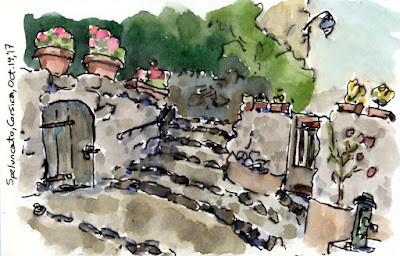The opening exhibition focuses on North Vancouver, with an appealing mix of photographs - some historical, some from the contemporary photographers that Vancouver is most famous for in the international art world - and sculptures and weaving, much of it from local First Nations artists. A huge light-box photo by Rodney Graham is one of my favourite local art works. It's visually very attractive, and has layer-upon-layer of interpretations (at least, I think so - I don't know what the "official" story is!)
The sculptures are a happy addition for sketchers, more fun to draw than trying to make a picture of a picture. I was joined by a couple of knee-high future artists drawing Gabrielle L'Hirondelle Hill's quirky piece made from parts found in the historical shipyards nearby. And I appreciated Cameron Kerr's large yellow-cedar sculpture representing a central element of North Vancouver culture - a bridge on the highway.













